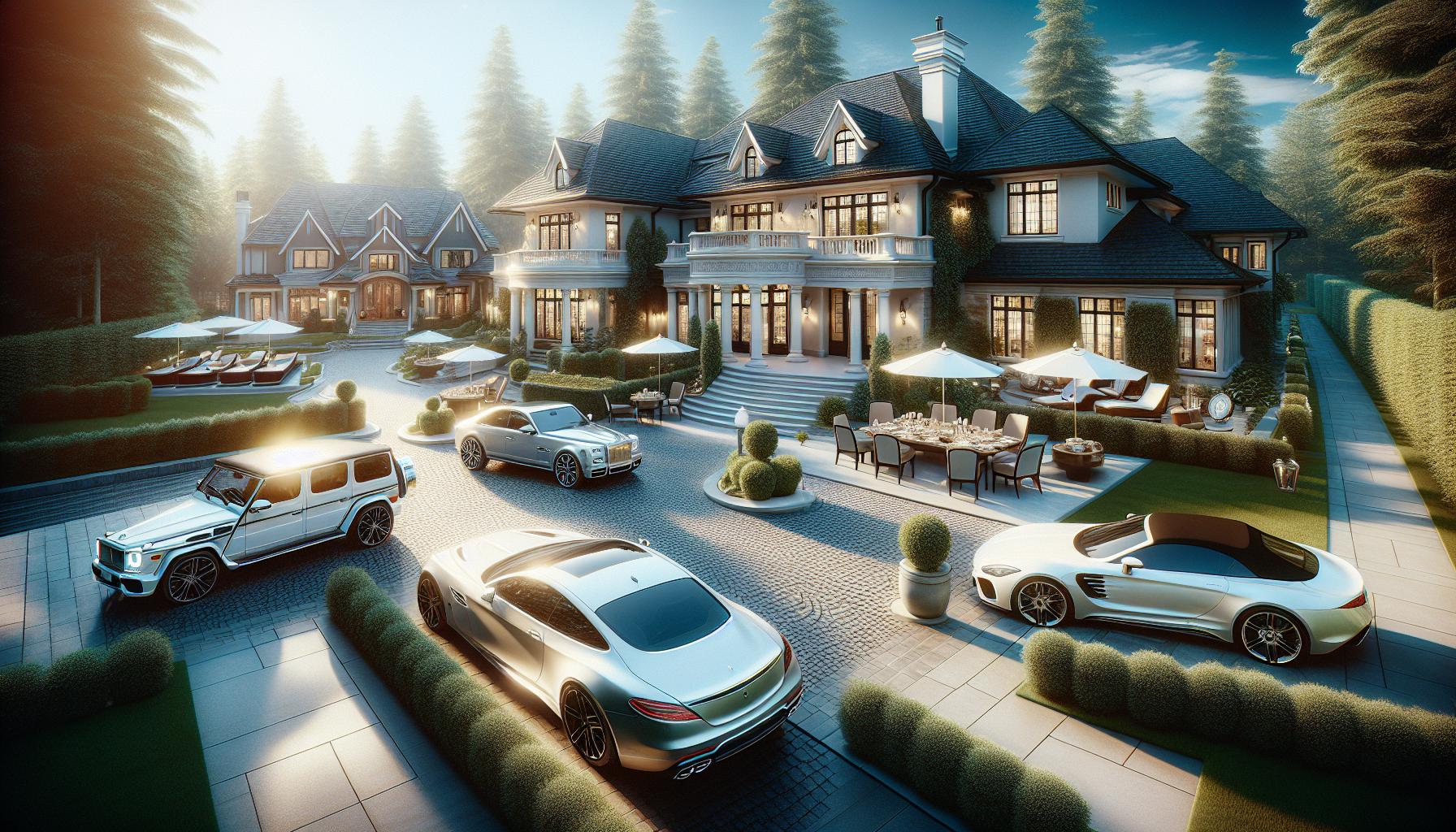Key Takeaways
- Understanding Luxury: A luxury lifestyle involves high-end experiences and indulgences, with costs varying based on personal preferences and location.
- Housing Costs: Luxury homes start around $1 million in suburban areas and can exceed $10 million in major cities, adding substantial monthly maintenance expenses.
- Transportation Expenses: High-end vehicles and private jets represent significant investments, with costs ranging from $100,000 to $90 million depending on type and specifications.
- Travel and Dining: Luxury vacations and fine dining are costly, with average expenses between $5,000 to $20,000 per week for travel and $200 to $500 per meal at upscale restaurants.
- Budgeting for Luxury: Achieving a luxury lifestyle typically requires an estimated income of at least $250,000 annually, factoring in various daily expenses and lifestyle choices.
- Income and Investments: Multiple income streams, strategic savings, and a diversified investment portfolio are essential for sustaining a luxury lifestyle without financial strain.
Living a luxury lifestyle often conjures images of lavish homes, exotic vacations, and gourmet dining. But how much money does it really take to turn those dreams into reality? The answer isn’t as straightforward as one might think, as it varies greatly depending on personal preferences, location, and lifestyle choices.
For some, luxury means enjoying high-end fashion and fine dining, while for others, it might involve owning a private yacht or traveling first class. Understanding the financial requirements for a luxury lifestyle can help individuals set realistic goals and make informed decisions about their spending. In this article, we’ll explore the key factors that influence the cost of living luxuriously and provide insights into how to achieve that desired lifestyle.
How Much Money do i Need to Live a Luxury Lifestyle
A luxury lifestyle encompasses high-end experiences and indulgences that often include lavish homes, exotic vacations, fine dining, and exclusive memberships. Individuals pursuing this lifestyle prioritize quality and uniqueness in their choices.
Key Elements of Luxury Living
- Housing: Luxury homes typically feature prime locations, expansive spaces, and top-tier amenities. Costs range from $1 million in suburban areas to over $10 million in metropolitan regions.
- Transportation: Possessing high-end vehicles, private jets, or yachts ranks as essential for many. Premium car prices often exceed $100,000, while private jet ownership costs range from $3 million to $90 million.
- Travel: Luxury vacations often involve five-star accommodations and first-class travel. Average expenses for such trips can reach $5,000 to $20,000 per person per week.
- Dining: Gourmet dining experiences often include upscale restaurants featuring multiple Michelin stars. Dining out at these venues can cost $200 to $500 per person for a single meal.
- Fashion and Accessories: Acquiring designer clothing and accessories remains a staple of luxury living. Spending on these items can easily surpass $1,000 for a single piece.
Influencing Factors
Location greatly impacts costs associated with a luxury lifestyle. Urban centers like New York or Los Angeles typically require higher expenditures than smaller cities. Additionally, personal preferences (e.g., choice of travel, dining, and entertainment) contribute significantly to overall expenses.
To maintain a luxury lifestyle, individuals often allocate a dedicated monthly budget for these expenses. An estimated income of at least $250,000 per year provides a foundation for achieving such a standard of living, yet actual figures vary based on individual circumstances and choices.
Key Factors Defining Luxury Lifestyle

Several factors significantly impact the cost of maintaining a luxury lifestyle. Understanding these elements aids in assessing individual financial requirements.
Location
Location plays a crucial role in luxury living costs. Luxury homes in suburban regions typically start at $1 million, while metropolitan areas can see prices exceed $10 million. Cities known for luxury lifestyles, such as New York and San Francisco, further inflate housing prices, where premium neighborhoods may demand upwards of $20 million for high-end properties. Additionally, local taxes and cost of living vary, influencing overall expenses.
Personal Preferences
Personal preferences dictate spending patterns and luxury choices. Individuals may prioritize specific luxuries, such as gourmet dining or designer fashion. For instance, a person favoring high-end cuisine might spend $500 per meal, while others may seek travel experiences that average between $5,000 and $20,000 weekly. These subjective tastes significantly alter the financial requirements to uphold a luxury lifestyle.
Lifestyle Choices
Lifestyle choices determine the scope of luxury expenses. Purchasing high-end vehicles can range from $100,000 for luxury cars to $90 million for private jets. Exclusive memberships to clubs or services add to monthly costs, with some requiring tens of thousands annually. Regular participation in luxury experiences, such as attending high-profile events, directly influences the financial burden associated with maintaining this lifestyle.
Cost Analysis

Understanding the costs associated with a luxury lifestyle helps in setting realistic financial goals. Several key areas contribute to the overall expenditure.
Housing and Real Estate
Luxury housing represents a significant financial investment. In suburban areas, luxury homes typically start at $1 million, while metropolitan regions often see properties exceeding $10 million. Monthly maintenance costs, property taxes, and homeowner association fees add another layer of expenses. For example, a $3 million home may incur monthly costs of $6,000 to $10,000. Thus, substantial income ensures not only the purchase but also the upkeep of these properties.
Transportation
Transportation costs vary widely in luxury lifestyles. High-end vehicles range from $100,000 to $500,000, while custom vehicles can exceed $1 million. For those seeking private jets, expenses skyrocket, with costs ranging from $3 million to $90 million, depending on aircraft type and specifications. Annual maintenance, fuel, and insurance add up to 10% to 15% of the aircraft’s value. In summary, the total transportation budget often reflects a commitment to sophistication and convenience.
Daily Expenses
Daily expenses for a luxury lifestyle can be considerable. Gourmet dining at upscale restaurants averages between $200 and $500 per person, which adds up quickly for frequent visits. Other daily expenditures, such as personal care and recreational activities, also contribute to overall costs. Individuals may spend an additional $2,000 to $5,000 monthly on items like high-end groceries, spa services, and exclusive memberships to clubs or gyms. These daily factors can easily lead to a monthly budget of $10,000 or more.
Calculating Your Luxury Budget

Establishing a concrete luxury budget involves assessing various financial aspects. These aspects include income sources and savings or investments, which significantly contribute to achieving a luxury lifestyle.
Income Sources
Identifying multiple income streams enhances the ability to sustain a luxury lifestyle. Common sources include:
- Salaries: High-paying jobs in industries like finance, technology, and medicine typically provide substantial salaries, often exceeding $150,000 annually.
- Business Income: Profits from owned businesses contribute significantly, with potential earnings varying widely based on industry performance.
- Investments: Returns from stocks, bonds, and real estate can generate passive income, with successful portfolios yielding 7% to 10% annually.
- Rental Income: Properties in affluent areas can yield considerable monthly rent, often ranging from $3,000 to $20,000, depending on location and property type.
- Royalties: Income from creative works or patents provides ongoing revenue, depending on demand and market value.
Savings and Investments
Strategic savings and investments build financial stability for luxury living. Key components include:
- Emergency Fund: Setting aside 6 to 12 months of living expenses ensures financial security, allowing for unplanned luxuries without strain.
- Retirement Accounts: Contributing to retirement accounts like 401(k)s or IRAs facilitates growth, with tax advantages that enhance long-term wealth.
- Real Estate Investments: Investing in luxury properties can appreciate significantly over time, often yielding profits and additional rental income.
- Diversified Portfolio: Maintaining a diversified investment portfolio minimizes risk and maximizes returns, balancing equities, bonds, and alternative assets.
- Luxury Savings: Allocating funds specifically for luxury experiences or items creates a distinct budget, ensuring access to desired luxuries without jeopardizing overall financial health.
Calculating luxury budgets requires a thorough understanding of income sources and financial strategies, enabling individuals to enjoy a lavish lifestyle sustainably.
Living a Luxury Lifestyle
Living a luxury lifestyle requires careful financial planning and a clear understanding of personal priorities. It’s essential to recognize that costs can vary widely based on location and individual preferences. By assessing income sources and creating a comprehensive budget, individuals can make informed decisions that align with their luxury aspirations.
Strategic savings and investments play a crucial role in sustaining this lifestyle while ensuring financial stability. With the right approach, enjoying the finer things in life can be both attainable and sustainable. Embracing a luxury lifestyle isn’t just about spending; it’s about creating a balanced financial foundation that supports long-term goals.